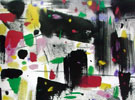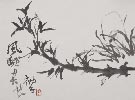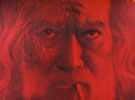A Talk between Li Wei and Tang Keyang
Tang Keyang: From the perspective of an architect, I care a lot about how space is generated on a painting, because painting is all about how to render a three-dimensional space on a two-dimensional medium. In this sense, I can see many facades, or many possibilities, from your works.
Mr. Zhao Li once said that lines and dots are two major modes of your works. Both of them take advantage of a blurred space. For example, the lines in your paintings are always accompanied by charcoal dust, which has a tendency of going deep. This kind of representation is hard to be explained with any modeling theory.
From the perspective of painting techniques, your works fall into two categories:
The first category creates abstract space with lines. It is easy for an architect to understand how simple lines form a three-dimensional space. Perspective drawing is a very good example. Starting with a single vanishing point, an entire space can be constructed. I think you use the same technique for your lines. An enchanting space is created not by perspective simulation, but by an overlapping of planes. The color and texture of your paintings seem to have combined some elements from handwork and mass production, which reminds me of modern landscape paintings.
Li Wei: It is all about density, the density of lines.
Tang Keyang: I think it is more of an abstract space or some sort of spiritual space. You can find many examples in traditional Chinese paintings. A good one is The Northern Wei Sarcophagus.
The second category is about your works based on dots, which show us a new possibility. The possibility is not about how to generate or simulate vision. It is about how a vision is converted to another. The first category of your works represents a process from abstract to concrete; the second, from concrete to abstract.
Li Wei: Do you have any examples?
Tang Keyang: For the first category, Paper Crane is a very good example. When you see it for the first time, what you see is a concrete image. You construct a space in your mind for your brain to explain and for your heart to feel. It is just like you see a circle first, and then you endow it with more attributes by imagining that the circle becomes a ball or teacup. For the second category, when I first see your painting of dots, it is a landscape. It is a landscape when viewed from afar. It becomes an array of dots when you get close to it. The experience is quite the opposite of what you see from the first category.
Li Wei: With the two viewing modes, I can freely deconstruct the original image, and then reconstruct it.
Tang Keyang: The second category is a new possibility of observing the structure of space and the world. The first category, however, is about how to identify the form you desire in a complicated environment. Despite their differences, they share some attributes in common. For example, both of them take advantage of a blurring effect. There is not a clear-cut demarcation between them and there is a possibility in the middle of them.
Li Wei: A lot of coincidences are waiting for us.
Tang Keyang: Yeah.
Li Wei: The reason is that I place great emphasis on the basic attribute of paintings.
Tang Keyang: I think the basic attribute of paintings is that they can render three-dimensional objects while they are flat themselves. What intrigues people is the uncertainty between the three-dimensional and two-dimensional, where the artist can switch back and forth. Instead of representing certain things, a work of art shows you constantly changing possibilities and makes your mind switch back and forth between the original object and your illusion.
In this sense, the concept of the original is deeply entrenched in the western painters’ mind. They enjoy the process of liberating themselves from the original object, no matter whether they are executing concrete paintings or abstract paintings. In my opinion, Chinese painters are more flexible in this regard, because they do not cling to the original at all. In other words, western paintings are either abstract or concrete, whereas Chinese painters prefer the state in the middle.
Li Wei: No matter whether I use dots or lines, I internationally prolong the process of painting. In doing so, I can experience the process little by little. There are always coincidences in the process. There are also unexpected results and I need to decide whether to keep the unexpected or not. The decision process is very important. I leave a trace of modification on my paintings, just like when time leaves its trail on them too.
Tang Keyang: It is said in your catalogue that your paintings’ topics are related to your experience. Compared with the life experience reflected in your works, I am more interested in the unexpected results you create. It is more interesting than embedding your experience in your works.
Li Wei: There are quite some surprises. Some of them are lost during the process of painting. Then I must work to retrieve them. The retrieval process is quite an experience.
Tang Keyang: Yeah, you then can go one step further. You can take your works out of your studio. There are many possibilities with the works as the environment surrounding makes them change from one kind to another. I suggest that you fully unleash the possibilities. Your works should not be plain paintings. Instead, they should interact with the surrounding environment.




